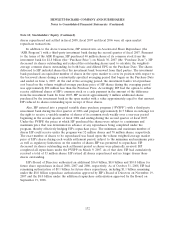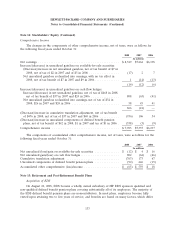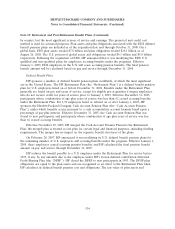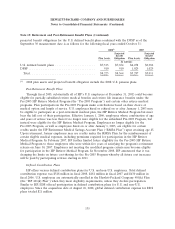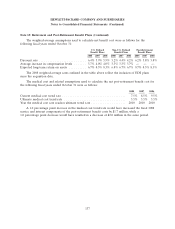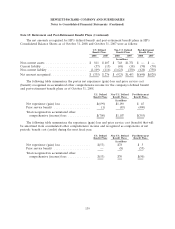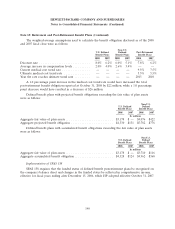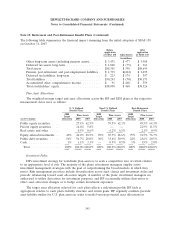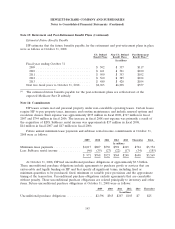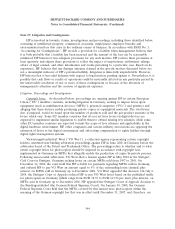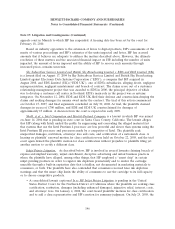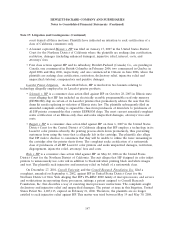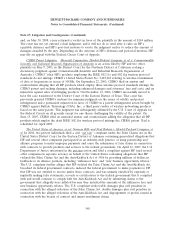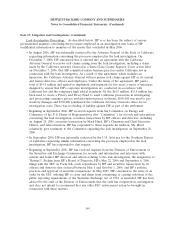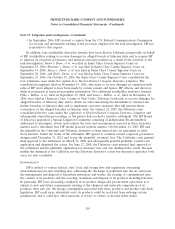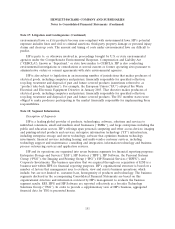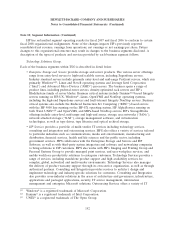HP 2008 Annual Report Download - page 148
Download and view the complete annual report
Please find page 148 of the 2008 HP annual report below. You can navigate through the pages in the report by either clicking on the pages listed below, or by using the keyword search tool below to find specific information within the annual report.HEWLETT-PACKARD COMPANY AND SUBSIDIARIES
Notes to Consolidated Financial Statements (Continued)
Note 15: Retirement and Post-Retirement Benefit Plans (Continued)
comparison to each plan’s forecasted liabilities and liquidity needs. HP invests a portion of the U.S.
defined benefit plan assets and post-retirement benefit plan assets in private market securities such as
venture capital funds, private debt and private equity to provide diversification and higher expected
returns.
Outside the United States, investment objectives are similarly aligned to generate returns that will
enable the plan to meet its future obligations. In some countries local regulations require adjustments
in asset allocation, typically leading to a higher percentage in fixed income than would otherwise be
deployed. HP’s corporate office acts in a governance role in periodically reviewing investment strategy
and providing a recommended list of investment managers for each country plan.
Basis for Expected Long-Term Rate of Return on Plan Assets
The expected long-term rate of return on assets for each U.S. plan reflects the expected returns
for each major asset class in which the plan invests, the weight of each asset class in the target mix, the
correlations among asset classes and their expected volatilities. Expected asset class returns reflect the
current yield on U.S. government bonds and risk premiums for each asset class. Because HP’s
investment policy is to employ primarily active investment managers who seek to outperform the
broader market, the asset class expected returns are adjusted to reflect the expected additional returns
net of fees.
In the beginning of fiscal 2008, HP implemented a liability-driven investment strategy for the U.S.
defined benefit pension plan, which was frozen effective December 31, 2007. As part of the strategy,
HP has transitioned its equity allocation to predominantly fixed income assets. The expected return on
the plan assets, used in calculating the net benefit cost, is 6.1% for fiscal 2009. The assets for the EDS
U.S. defined benefit plan are primarily invested in equity related investments. The expected return on
the plan assets, used in calculating the net benefit cost for the EDS defined benefit plan, is 9.3% for
fiscal 2009.
The approach used to arrive at the expected rate of return on assets for the non-U.S. plans reflects
the asset allocation policy of each plan to the expected country real returns for equity and fixed income
investments. On an annual basis, HP gathers empirical data from the local country subsidiaries to
determine expected long-term rates of return for equity and fixed income securities. HP then weights
these expected real rates of return based on country specific allocation mixes adjusted for inflation.
Future Contributions and Funding Policy
In fiscal 2009, HP expects to contribute approximately $360 million to its pension plans including
EDS, and approximately $35 million to cover benefit payments to U.S. non-qualified plan participants.
HP expects to pay approximately $70 million to cover benefit claims for HP’s post-retirement benefit
plans. HP’s funding policy is to contribute cash to its pension plans so that it meets at least the
minimum contribution requirements, as established by local government, funding and taxing authorities.
142


